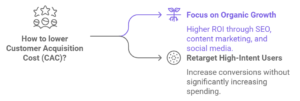In a world where traditional marketing often focuses on short-term wins and vanity metrics, growth marketing emerges as a fresh, data-driven, and holistic approach.
At its core, growth marketing aims to foster long-term, sustainable growth by focusing on the entire customer lifecycle—from acquisition to retention and expansion. By understanding the key objectives of growth marketing, businesses can implement strategies that increase customer numbers, build loyalty, and drive overall profitability.
In this article, we’ll explore the key objectives of growth marketing and how they serve as the backbone for modern, scalable marketing efforts.
Objective 1: Driving Sustainable, Long-Term Growth
The ultimate goal of growth marketing is to achieve sustainable growth that lasts. It’s not just about short bursts of customer acquisition but about laying the groundwork for a long-term strategy that continuously delivers value to both the company and its customers.
Focus on Retention and Expansion
Unlike traditional marketing, which tends to prioritize acquisition, growth marketing emphasizes acquisition with an added focus on customer retention and expansion. Keeping existing customers happy and engaged often leads to more revenue than acquiring new ones.
Growth marketers invest in customer relationship management (CRM), loyalty programs, and personalized marketing efforts to increase customer lifetime value (CLV).

By nurturing customer relationships, businesses can drive repeat sales, encourage referrals, and reduce churn.
Expanding into New Markets
Growth marketing also focuses on expanding the business into new markets and verticals. Whether it’s through launching new products, diversifying services, or entering new geographical regions, growth marketers use data-driven insights to identify growth opportunities.
Market research and experimentation are essential to determining the most effective strategies for scaling a business.
Objective 2: Optimizing Customer Acquisition Through Experimentation
Experimentation is a hallmark of growth marketing, making it fundamentally different from traditional approaches. A growth marketer’s toolbox is filled with tactics like A/B testing, multivariate testing, and behavioral analysis to fine-tune campaigns and boost acquisition rates. In the absence of the experiment mindset, growth marketing has no room.
A/B Testing and Multivariate Testing
Growth marketing thrives on the concept of experimentation. A/B testing allows marketers to test different versions of web pages, emails, and ad creatives to find what resonates best with the audience. Multivariate testing goes a step further, testing multiple variables simultaneously to determine the most effective combinations.
This focus on continuous experimentation enables marketers to optimize performance and achieve better results over time. By constantly testing, businesses can pinpoint what drives conversions and refine their strategies accordingly.
Data-Driven Decision Making
Growth marketing is heavily reliant on data to inform decisions. By using tools like Google Analytics, customer surveys, and behavioral tracking software, growth marketers gain a deeper understanding of their target audience.
Data-driven insights help adjust marketing efforts, craft personalized experiences, and ensure that every marketing dollar spent has a higher return on investment (ROI).
Neil Patel’s article on growth marketing explains how data-driven decision-making is key to growth marketing, highlighting its importance for achieving long-term goals.
Objective 3: Increasing ROI Through Multi-Channel Marketing
Growth marketing doesn’t restrict itself to a single channel but leverages multiple channels to optimize customer engagement and increase ROI. This objective aligns with a holistic strategy that integrates SEO, social media, content marketing, email marketing, and performance advertising.
Leveraging Diverse Channels
To increase the chances of reaching potential customers, growth marketers create a multi-channel approach. They tap into organic channels like SEO and content marketing, while also investing in paid performance channels such as Google Ads or social media advertising. This not only broadens the scope of reach but also improves the ability to target specific audiences.
Cross-Channel Attribution
One of the core objectives of growth marketing is understanding how different channels work together to generate conversions. Cross-channel attribution helps marketers understand the touchpoints a customer encounters before converting. This knowledge enables them to allocate budgets effectively across channels, ensuring every channel is optimized for performance.
Objective 4: Enhancing Customer Experience and Engagement
Customer experience is at the heart of growth marketing. Marketers aim to create personalized, seamless journeys that engage customers and foster long-term relationships.
Creating a Seamless User Journey
Growth marketing strives to remove any friction from the customer’s journey. Whether it’s the onboarding process, browsing experience, or checkout flow, the aim is to ensure every interaction is smooth and enjoyable. A seamless user journey is essential for reducing drop-offs and enhancing customer satisfaction.
Fostering Engagement Through Personalization
Personalization is key to keeping customers engaged. Growth marketers use tools like email automation and retargeting to deliver personalized messages at the right time. For instance, personalized product recommendations or tailored content offers can significantly increase engagement rates. This helps foster deeper relationships with customers, leading to repeat purchases and advocacy.
Experience Welcome provides further insights into how personalization enhances customer engagement, emphasizing its role in achieving long-term sustainable growth.
Objective 5: Improving Agility in Marketing Campaigns
In a fast-paced digital world, agility is a necessity, not a luxury. Growth marketing aims to improve the speed and flexibility of marketing campaigns to adapt quickly to changing market conditions.
Real-Time Adaptation to Market Trends
Growth marketers are always on the lookout for new trends and shifts in customer behavior. By staying agile, they can quickly tweak their marketing strategies to align with these trends. Whether it’s altering ad copy, adjusting targeting parameters, or even pivoting the overall strategy, agility ensures that businesses can stay ahead of the competition.
Growth Hacking and Quick Iteration
Growth hacking refers to the process of experimenting across different marketing channels and product development strategies to find the most effective way to scale a business. Quick iteration is crucial in this process, allowing marketers to test hypotheses, gather feedback, and implement changes rapidly.
Objective 6: Lowering Customer Acquisition Cost (CAC)
Lowering CAC is a major objective for any growth marketer. By refining targeting and optimizing marketing spend, businesses can acquire new customers more cost-effectively.
Maximizing the Efficiency of Marketing Spend
Growth marketing aims to lower CAC by focusing on organic growth channels like SEO, content marketing, and social media. These channels often have a higher ROI compared to paid campaigns. Additionally, growth marketers employ retargeting campaigns to focus on high-intent users, increasing the likelihood of conversions without drastically increasing spending.

Targeting High-Intent Prospects
By using advanced analytics and customer insights, growth marketers can identify high-intent prospects who are more likely to convert. This reduces wasted marketing efforts and ensures that the marketing budget is spent efficiently.
The Growth Agency’s approach offers insights into how data-driven strategies can reduce CAC and drive more qualified leads through targeted marketing efforts.
Objective 7: Aligning Marketing with Business Goals
For growth marketing to succeed, it must be fully aligned with the company’s broader business goals, including revenue generation, customer satisfaction, and brand recognition.
Bridging Marketing and Sales
Growth marketing bridges the gap between marketing and sales teams, ensuring that both are working toward the same objectives. This alignment helps streamline the customer acquisition process and ensures that leads generated by marketing are high quality and likely to convert.
Contributing to Revenue Growth
Ultimately, growth marketing aims to drive revenue growth. This is achieved by implementing data-backed strategies that focus on customer acquisition, retention, and upselling. Regularly monitoring key performance indicators (KPIs) like lead-to-customer conversion rates and customer lifetime value helps marketers ensure they are meeting the company’s revenue goals.
Objective 8: Scaling Efficiently Through Automation
As businesses grow, manual marketing processes become unsustainable. One of the key objectives of growth marketing is to scale marketing efforts efficiently through automation.
Automating Marketing Campaigns
Automation tools like HubSpot, ActiveCampaign, and Mailchimp allow growth marketers to automate time-consuming tasks like email marketing, social media posting, and lead nurturing. This frees up time for more strategic initiatives and ensures that marketing efforts can scale as the business grows.
Streamlining Lead Nurturing
Automating lead nurturing workflows is essential for scaling a business. By setting up automated email drip campaigns or triggered sequences, businesses can guide potential customers through the sales funnel without manual intervention, ensuring a consistent and efficient process.
How Growth Marketing Objectives Drive Success
Growth marketing is not just about getting new customers—it’s about retaining them, engaging them, and fostering long-term relationships that drive sustainable business growth. By focusing on objectives like customer retention, data-driven experimentation, multi-channel marketing, and automation, growth marketing strategies help businesses thrive in an ever-competitive landscape.
Whether you’re a startup looking to scale or an established company aiming for higher ROI, embracing the objectives of growth marketing is the key to unlocking your potential for long-term success.


